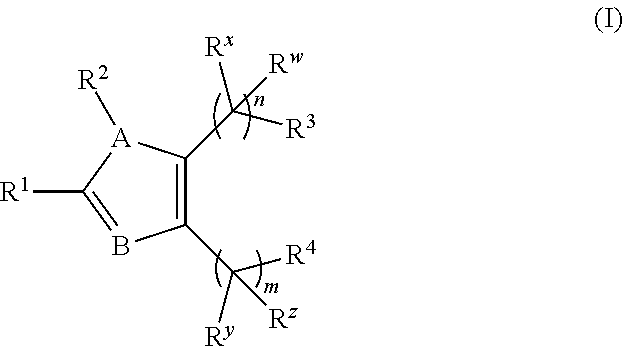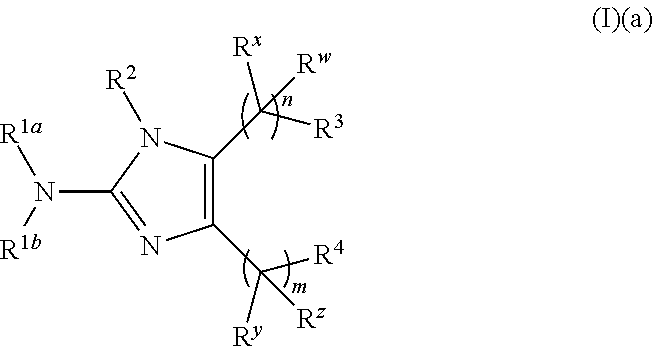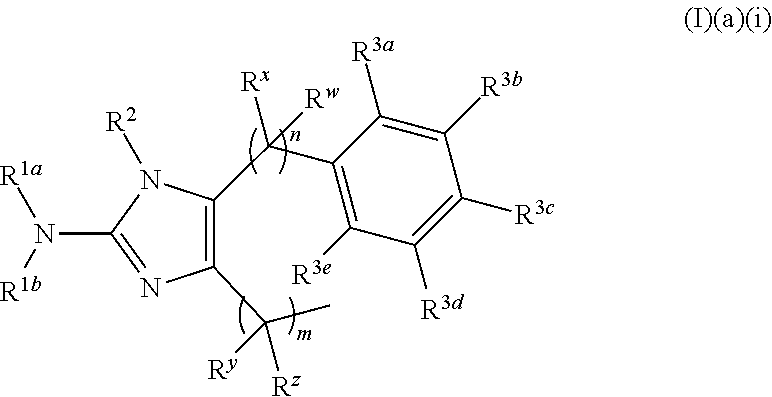Inhibition of bacterial biofilms and microbial growth with imidazole derivatives
a technology of imidazole and microbial growth, which is applied in the field of inhibition of bacterial biofilms and microbial growth with imidazole derivatives, can solve the problems of inability to eradicate these infections, inability to effectively eliminate infections, and deleterious effects of biofilms in non-medical settings, and achieve the effect of enhancing the effect of a plant defense activator
- Summary
- Abstract
- Description
- Claims
- Application Information
AI Technical Summary
Benefits of technology
Problems solved by technology
Method used
Image
Examples
example 1
[0239]A library of 4,5-disubstituted-2-aminoimidazoles was synthesized using a nitroenolate route and then screened for antibiofilm and antimicrobial activity. These compounds displayed notable biofilm dispersal and planktonic microbicidal activity against various Gram-positive and Gram-negative bacteria.
[0240]The synthesis of 4,5-disubstituted-2-aminoimidazoles was accomplished via a nitroenolate approach (Scheme 1) because the starting building blocks, activated carboxylic acids and alkyl nitro derivatives, are either commercially available or available in one step from either carboxylic acids or alkyl halides respectively. Once assembled, the target α-nitro ketones could simply be reduced and then condensed with cyanamide to yield 4,5-disubstituted-2-aminoimidazoles. See Ballini et al., Tetrahedron, 2005, 61, 8971-8993.
[0241]
[0242]This synthetic approach was first optimized by using 4-phenylbutryic acid and nitromethane as the building blocks. A combination of enolization base, c...
example 2
Activity Testing of First and Second Generation Library Members on Plant or Plant Part Pathogens
[0296]A standard crystal violet reporter assay is employed to assess the effect of compounds from the libraries reported above in Example 1 on the formation or dispersion of biofilms and / or microbial growth (e.g., bacterial strains, fungal strains, etc.) on plants or plant parts.
PUM
| Property | Measurement | Unit |
|---|---|---|
| temperatures | aaaaa | aaaaa |
| temperatures | aaaaa | aaaaa |
| concentration | aaaaa | aaaaa |
Abstract
Description
Claims
Application Information
 Login to View More
Login to View More - R&D
- Intellectual Property
- Life Sciences
- Materials
- Tech Scout
- Unparalleled Data Quality
- Higher Quality Content
- 60% Fewer Hallucinations
Browse by: Latest US Patents, China's latest patents, Technical Efficacy Thesaurus, Application Domain, Technology Topic, Popular Technical Reports.
© 2025 PatSnap. All rights reserved.Legal|Privacy policy|Modern Slavery Act Transparency Statement|Sitemap|About US| Contact US: help@patsnap.com



